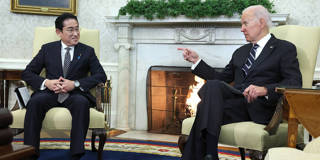In the face of the threats posed by China, Russia, and North Korea, Japan’s self-defense depends more than ever on the strength of its alliances. By significantly increasing its own defense spending and pursuing closer military cooperation with the United States, the current government is moving in the right direction.
CAMBRIDGE – Last December, Japanese Prime Minister Fumio Kishida announced the most ambitious expansion of military power in Japan since the creation of the country’s Self-Defense Forces in 1954. Japanese defense spending will rise to 2% of GDP – twice the 1% level that has prevailed since 1976 – and a new National Security Strategy lays out all the diplomatic, economic, technological, and military instruments that Japan will use to protect itself in the years ahead.
Most notably, Japan will acquire the kind of long-range missiles that it had previously foresworn, and it will work with the United States to strengthen littoral defenses around the “first island chain” off China. Last month in Washington, following Kishida’s diplomatic tour through several other G7 countries, he and US President Joe Biden pledged closer defense cooperation. Among the factors precipitating these changes are China’s increased assertiveness against Taiwan and, especially, Russia’s invasion of Ukraine, which reminded a new generation of what military aggression looks like.
Of course, some of Japan’s neighbors worry that it will resume its militarist posture of the 1930s. When Kishida’s predecessor, Abe Shinzō, broadened the constitutional interpretation of self-defense to include collective undertakings with Japanese allies, he stoked concerns both within the region and from some segments of Japanese society.

CAMBRIDGE – Last December, Japanese Prime Minister Fumio Kishida announced the most ambitious expansion of military power in Japan since the creation of the country’s Self-Defense Forces in 1954. Japanese defense spending will rise to 2% of GDP – twice the 1% level that has prevailed since 1976 – and a new National Security Strategy lays out all the diplomatic, economic, technological, and military instruments that Japan will use to protect itself in the years ahead.
Most notably, Japan will acquire the kind of long-range missiles that it had previously foresworn, and it will work with the United States to strengthen littoral defenses around the “first island chain” off China. Last month in Washington, following Kishida’s diplomatic tour through several other G7 countries, he and US President Joe Biden pledged closer defense cooperation. Among the factors precipitating these changes are China’s increased assertiveness against Taiwan and, especially, Russia’s invasion of Ukraine, which reminded a new generation of what military aggression looks like.
Of course, some of Japan’s neighbors worry that it will resume its militarist posture of the 1930s. When Kishida’s predecessor, Abe Shinzō, broadened the constitutional interpretation of self-defense to include collective undertakings with Japanese allies, he stoked concerns both within the region and from some segments of Japanese society.